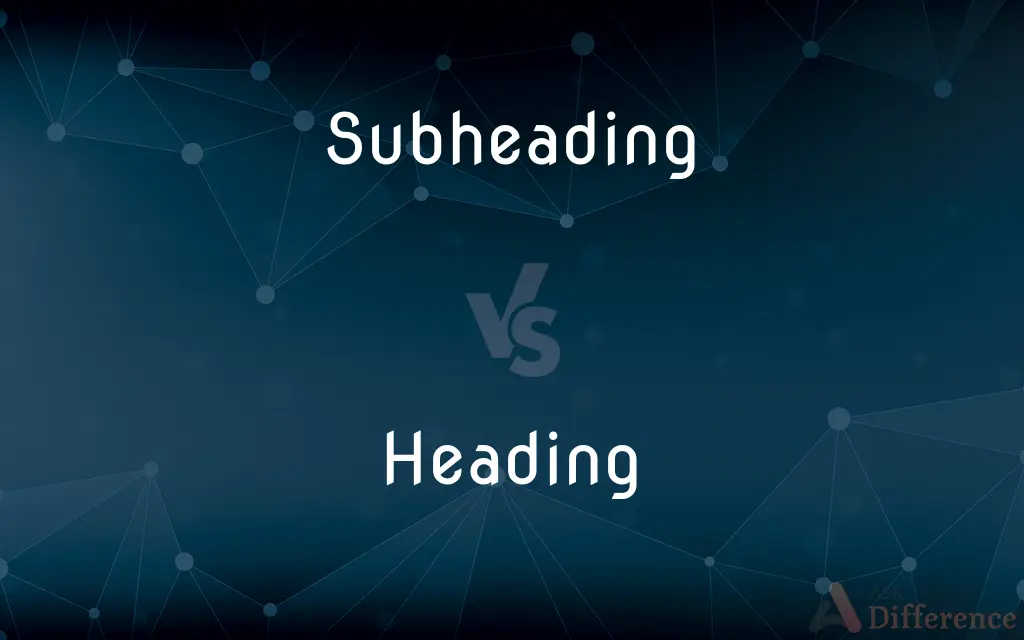Subheading vs. Heading — What's the Difference?
By Fiza Rafique & Maham Liaqat — Updated on March 28, 2024
A heading serves as the title or main identifier of a section, providing an overview, while a subheading breaks down the section further, offering more specific details.

Difference Between Subheading and Heading
Table of Contents
ADVERTISEMENT
Key Differences
Headings are crucial in organizing content, signaling the beginning of a new section or topic. They are designed to capture the essence of the content that follows, often being bold and larger in font size to stand out. Subheadings, on the other hand, fall under headings to break down the content into more digestible parts, guiding readers through a detailed exploration of the topic. Subheadings help in structuring the content hierarchically, making it easier to navigate.
While a heading might broadly categorize the main idea, such as "History of the Internet," subheadings would segment this topic into finer points, like "The Invention of the World Wide Web," "Evolution of Search Engines," and "The Rise of Social Media." This structure allows readers to quickly grasp the scope of the content and locate specific information within a larger context.
Headings typically utilize a higher level of hierarchy in formatting styles, such as H1 or H2 in HTML, indicating their importance in structuring the document. Subheadings might use H3, H4, or lower, reflecting their role in further dividing the content under the main headings. This hierarchical structure is essential for SEO (Search Engine Optimization), as it helps search engines understand the content's organization and relevance.
In academic or formal writing, headings and subheadings follow specific style guidelines, such as those outlined by APA or MLA formats, which dictate their appearance, numbering, and alignment. These conventions ensure consistency and clarity across different types of documents, aiding in the reader's comprehension.
The use of headings and subheadings is not limited to text documents; they play a significant role in presentations, websites, and even videos, where they help organize information and guide the audience's attention. By effectively employing headings and subheadings, creators can enhance readability, facilitate navigation, and emphasize key points within their content.
ADVERTISEMENT
Comparison Chart
Purpose
Provides detailed breakdowns within a section
Introduces the main topic or section
Position in Hierarchy
Under headings, indicating sub-sections
Higher, often the title of a section or document
Font Size
Smaller than headings, but larger than text
Typically larger
Formatting
Often bold, but less prominent than headings
Bold, distinctive style
HTML Tags
H3, H4, or lower
H1, H2
SEO Importance
Helps in organizing content for readability
Crucial for understanding content structure
Guidelines
Aligned with the hierarchy under headings
Follow specific formatting styles (APA, MLA)
Use in Documents
Detail specific aspects of the broader topic
Begin sections, introduce topics
Navigation Aid
Allows for detailed navigation within sections
Helps in scanning document structure
Compare with Definitions
Subheading
Breaks down the section into more detailed parts.
The Role of Antibiotics.
Heading
The title or main identifier of a content section.
Chapter 1: Introduction.
Subheading
Typically uses H3, H4, or lower in HTML.
<h3>Case Study: The 2020 Pandemic</h3>.
Heading
Larger and bolder than subheadings for emphasis.
Global Warming: An Overview.
Subheading
Guides readers through detailed exploration within sections.
Factors Influencing Climate Change.
Heading
Utilizes H1 or H2 in HTML for web content organization.
<h1>About Us</h1>.
Subheading
Helps organize complex content for easier navigation.
Data Analysis Techniques.
Heading
Signals the start of a new topic or section.
The Renaissance Period.
Subheading
Smaller and less bold than headings, but stands out from the text.
Early Discoveries.
Heading
Follows specific style guidelines in formal documents.
Methodology.
Subheading
A heading given to a subsection of a piece of writing
The page is broken up into short paragraphs with subheadings
This project falls under the subheading of ‘Skills and the Workforce’
Heading
A title at the head of a page or section of a book
Chapter headings
Subheading
See subhead.
Heading
A direction or bearing
He crawled on a heading of 90 degrees until he came to the track
Subheading
Any of the headings under which each of the main divisions of a subject may be subdivided
Heading
A horizontal passage made in preparation for building a tunnel.
Subheading
A heading or caption subordinate to a main headline, heading, or title especially when inserted as a divider between sections (as of a newspaper or periodical article or story or text of a book)
Heading
A strip of cloth at the top of a curtain above the hooks or wire by which it is suspended.
Subheading
A heading of a subdivision of a text
Heading
The title, subtitle, or topic that stands at the top or beginning, as of a paragraph, letter, or chapter.
Heading
The course or direction in which a ship or aircraft is pointing or moving.
Heading
A gallery or drift in a mine.
Heading
The end of a gallery or drift.
Heading
Present participle of head
Heading
The title or topic of a document, article, chapter, or of a section thereof.
Put the information under the "Advantages" heading
Heading
(nautical) The direction into which a seagoing or airborne vessel's bow is pointing (apparent heading) and/or the direction into which it is actually moving relative to the ground (true heading)
Heading
Material for the heads of casks, barrels, etc.
Heading
(mining) A gallery, drift, or adit in a mine; also, the end of a drift or gallery; the vein above a drift.
Heading
(sewing) The extension of a line ruffling above the line of stitch.
Heading
(masonry) The end of a stone or brick which is presented outward.
Heading
(flags) A strip of material at the hoist end of a flag, used for attaching the flag to its halyard.
Heading
The act or state of one who, or that which, heads; formation of a head.
Heading
That which stands at the head; title; as, the heading of a paper.
Heading
Material for the heads of casks, barrels, etc.
Heading
A gallery, drift, or adit in a mine; the vein above a drift.
Heading
The extension of a line ruffling above the line of stitch.
Heading
That end of a stone or brick which is presented outward.
Heading
A line of text serving to indicate what the passage below it is about;
The heading seemed to have little to do with the text
Heading
The direction or path along which something moves or along which it lies
Heading
A horizontal (or nearly horizontal) passageway in a mine;
They dug a drift parallel with the vein
Common Curiosities
What is a heading?
A heading is the title or main label of a content section, designed to introduce and categorize the main topic.
How do headings contribute to SEO?
Headings help search engines understand the structure and hierarchy of content, improving the document's searchability and relevance.
What is a subheading?
A subheading is a secondary title under a heading that provides more specific details or breaks down the section into finer parts.
How do headings and subheadings differ in formatting?
Headings are typically larger, bolder, and stand out more, while subheadings are smaller than headings but still distinct from the main text.
Why are headings and subheadings important in a document?
They organize content, making it easier for readers to navigate and understand the structure and key points of the document.
Can a section have multiple subheadings?
Yes, sections can have multiple subheadings to detail various aspects of the topic covered under a single heading.
What role do headings and subheadings play in web content?
They organize content for readers and search engines, enhancing usability and SEO.
Are there rules for numbering headings and subheadings?
Yes, formal documents often use a numbering system to indicate the hierarchy and order of sections.
How should headings and subheadings be used in academic writing?
Follow the specific formatting and style guidelines (e.g., APA, MLA) for consistency and clarity.
How can headings and subheadings improve comprehension?
By clearly delineating sections and topics, they help readers understand the main points and how the content is organized.
Do all documents need headings and subheadings?
While not all documents require them, headings and subheadings greatly enhance readability and organization in most types of written content.
What is the importance of consistency in headings and subheadings?
Consistent use of style and formatting helps maintain clarity and coherence throughout the document.
Can headings and subheadings contain keywords for SEO?
Yes, including relevant keywords in headings and subheadings can improve a document's search engine visibility.
How do headings and subheadings facilitate navigation?
They act as signposts, guiding readers through the document and allowing for quick access to specific content sections.
Can headings and subheadings be used in presentations?
Yes, they are effective in organizing presentation content and guiding the audience through the discussion points.
Share Your Discovery

Previous Comparison
Dent vs. Ding
Next Comparison
Burr vs. BurlAuthor Spotlight
Written by
Fiza RafiqueFiza Rafique is a skilled content writer at AskDifference.com, where she meticulously refines and enhances written pieces. Drawing from her vast editorial expertise, Fiza ensures clarity, accuracy, and precision in every article. Passionate about language, she continually seeks to elevate the quality of content for readers worldwide.
Co-written by
Maham Liaqat














































